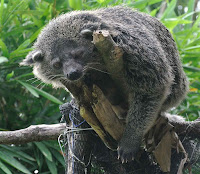 |
| El Nido-Corong Corong |
"Palawan is composed of the long and narrow Palawan Island, plus a number of other smaller islands surrounding the main island. The Calamianes Group of Islands to the Northeast consists of Busuanga Island, Coron Island and Culion Island. Durangan Island almost touches the westernmost part of Palawan Island, while Balabac Island is located off the southern tip, separated from Borneo by the Balabac Strait. In addition, Palawan covers the Cuyo Islands in the Sulu Sea. The disputed Spratly Islands, located a few hundred kilometres to the west, are considered part of Palawan by the Philippines, and is locally called the "Kalayaan Group of Islands."
Palawan's almost 2,000 kilometres (1,200 mi) of irregular coastline are dotted with roughly 1,780 islands and islets, rocky coves, and sugar-white sandy beaches. It also harbors a vast stretch of virgin forests that carpet its chain of mountain ranges. The mountain heights average 3,500 feet (1,100 m) in altitude, with the highest peak rising to 6,843 feet (2,086 m) at Mount Mantalingahan. The vast mountain areas are the source of valuable timber. The terrain is a mix of coastal plain, craggy foothills, valley deltas, and heavy forest interspersed with
riverine arteries that serve as irrigation." From Wikipedia on Palawan
Palawan's Natural Bounty
 |
| Scaly anteater or pangolin. Found only in Palawan and is the most poached animal in the world. |
105 out of the 475 threatened species in the Philippines. 42 are Palawan endemics.
379 species of corals; 82% of the total coral species recorded in the entire country
90% of the known mangrove species in the country, distributed in 44,500 hectares of mangrove forests, the highest remaining mangrove cover in the Philippines.
4 of 5 marine turtles
15 of the 25 marine mammals in the country
18 endemic freshwater fish
26 endemic amphibians
16 endemic terrestrial mammals
279 species of birds
15 lakes, 42 ponds, 44 waterfalls, 72 natural springs, 9 mineral springs, 28 principal rivers, 43 streams, and 165 creeks identified as potential sources of water for domestic consumption and irrigation
At least 1,700 plant species
379 species of corals found in Palawan and 82% of the total coral species recorded in the country.
Other sites:
Save Palawan:https://pnni.wordpress.com/palawan-biodiversity-facts-and-figures/


No comments:
Post a Comment